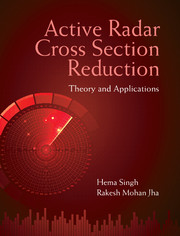Book contents
- Frontmatter
- Dedication
- Contents
- List of Tables
- List of Figures
- List of Abbreviations
- Preface
- Acknowledgements
- 1 Introduction to Radar Cross Section Reduction
- 2 RAM Analysis for Low-Observable Platforms
- 3 Radar Cross Section of Phased Antenna Arrays
- 4 Active RCS Reduction in Phased Arrays
- 5 Mutual Coupling Effects in Phased Arrays
- 6 RCS of Dipole Array Including Mutual Coupling Effects
- 7 Performance of Sidelobe Cancellers in Active RCSR
- 8 Emerging RCSR Techniques
- Epilogue
- Appendices
- List of Symbols
- Suggestions for Further Reading
- Author Index
- Subject Index
1 - Introduction to Radar Cross Section Reduction
Published online by Cambridge University Press: 05 April 2015
- Frontmatter
- Dedication
- Contents
- List of Tables
- List of Figures
- List of Abbreviations
- Preface
- Acknowledgements
- 1 Introduction to Radar Cross Section Reduction
- 2 RAM Analysis for Low-Observable Platforms
- 3 Radar Cross Section of Phased Antenna Arrays
- 4 Active RCS Reduction in Phased Arrays
- 5 Mutual Coupling Effects in Phased Arrays
- 6 RCS of Dipole Array Including Mutual Coupling Effects
- 7 Performance of Sidelobe Cancellers in Active RCSR
- 8 Emerging RCSR Techniques
- Epilogue
- Appendices
- List of Symbols
- Suggestions for Further Reading
- Author Index
- Subject Index
Summary
Introduction
The concept of stealth or radar cross section (RCS) reduction and control has been a topic of interest since World War II. Attempts were initially made to reduce the detectability of the aircraft by employing wood and other composites as aircraft materials since they were less reflective to the radar waves than a metal. Following the initial systematisation, one realised that shaping and coating [by radar-absorbing materials (RAMs)] emerged as the primary techniques for the RCS reduction (RCSR).
RCSR through shaping is readily apparent in case of stealth fighter aircraft F-22. The edges at principal and drooping ends of wings and rear end of the aircraft have similar angular sweep. Further, the fuselage and canopy are smooth-surfaced with slopes at sides. The shapes of the surface interfaces, such as the doors at bay and the seam of the canopy, are saw-wave-type. The vertical airfoil of aircraft tails is slant. The front side of its engine is obliterated and includes a serpentine-shaped engine duct. Finally, all the weapons are stored within the aircraft itself. These alterations in the conventional shape of the aircraft resulted in considerable RCSR of the aircraft.
In contrast, RAM coatings have been used since 1950s to achieve low-RCS aircraft design. RAM was also useful in mitigating the coupling effect and cross talk between the antennas mounted on the surface of the aircraft. The reconnaissance airplane Lockheed U-2 and the fighter aircraft F-117 are few examples where RAM has been used for RCSR.
Sufficient knowledge base was created over time regarding the scattering behaviour of aircraft structures. The parameters that played a significant role in overall scattering characteristics of these structures were identified. For example, flat plates and cavities were observed to result in large radar return at normal incidence. Similarly, the inlet and exhaust systems of the fighter aircraft were identified as significant contributors towards the aircraft RCS in front-on and rear-on angles, while its vertical tail dominated the radar signature from other angles at the sides.
- Type
- Chapter
- Information
- Active Radar Cross Section ReductionTheory and Applications, pp. 1 - 14Publisher: Cambridge University PressPrint publication year: 2015



